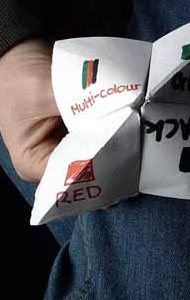|
|
Date: 2005
Project Type: Game


Exercise for James R. Ford's
Fortune Tower
Description
Fortune Tower is a digital reinterpretation of the classic children's playground game Fortune Teller. However, in Ford's version the hands are mysteriously anonymous. Does the viewer play the game with the artist, the computer, or someone on the Internet? School children from Nottingham, England, who the artist met on a train, made the actual Fortune Teller object. From the artist's perspective, the piece evokes nostalgia and memories of childhood. The interactive animation is displayed on a flat LCD monitor with a computer mouse in a gallery setting.
Purpose
This exercise should help students think about how traditional activities, particularly games, are translated on the web.
Exercise
Warm-Up Activity (5 min): Teachers should ask students what their common everyday activities are? For instance, shopping, banking, communicating and discuss how these activities can happen online. For instance, retail stores online, online banking and email. Play (10 min): Breaking into small groups, students should play Fortune Tower. Each student should get a chance to play twice.
Follow-up Discussion (10 min): The educator should lead an interpretative discussion about the piece. Suggested questions could include:
- Did the students enjoy the piece?
- Did the students play Fortune Tower like when they were children?
- Was the interface (see glossary) effective?
- How does the game change in a digital envrionment?
- Does the game get enhanced, worsen, or just seem different?
- What are simple games that students played as children (for instance, checkers, jump rope, skipping stones)?
- Do the students think these games could be translated onto the web?
Activity (25 min): The educator should write up different games that students listed. In small groups, students should consider how these games could work digitally. They need to ask themselves the following questions:
- How will the game change if there is no physical interaction?
- What is the core action of the game? How can this be represented online?
- What would the interface be like?
- How does the game end?
Students should draw how the game would look and list a set of rules. At the end of class, the small groups should present their virtual games.
|






